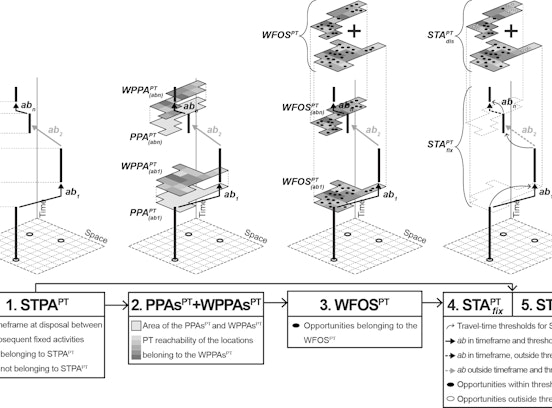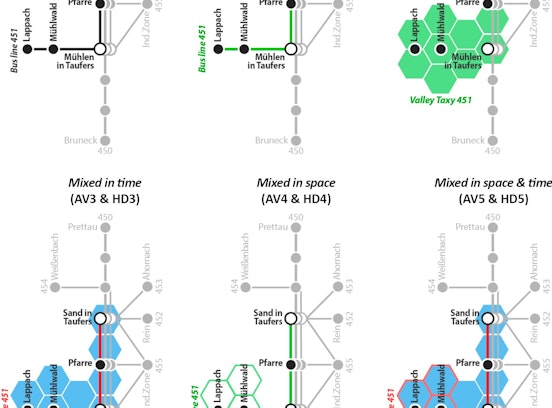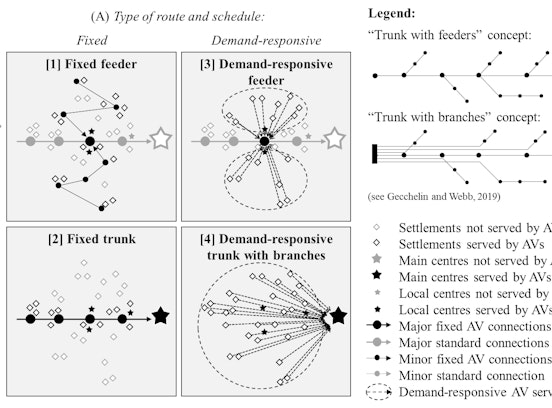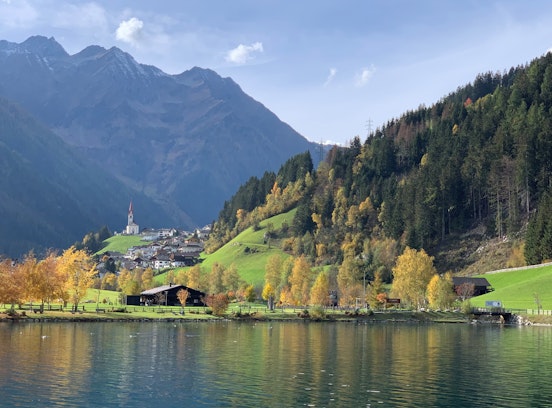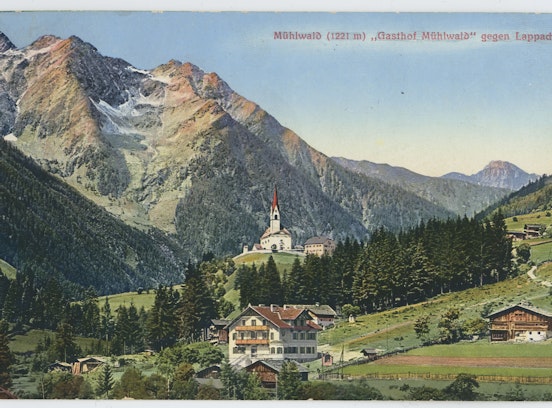RAAV
Rural Acessibility & Automated Vehicles
- Project duration: -
- Project status: finished
- Funding: Provincial Joint Programme – IT-FWF (Province BZ funding / Project)
- Total project budget: €382,891.00
- Website: https://www.fwf.ac.at/en/research-radar/10.55776/I5224
- Institute: Institute for Regional Development
Rural dwellers often experience poor accessibility. This applies especially to groups like elderly and pupils who mostly depend on public transport, or to the adult members of large-size households who have stronger space-time constraints. Automated vehicles (AVs) may greatly change this condition. Thanks to the cost savings they are supposed to generate, AVs could increase the competitiveness of traditional public transport or enable the introduction of alternative demand-responsive services. In their turn, these service improvements could affect the accessibility of different population groups and of rural communities as a whole.
PROJECT GOAL AND STRUCTURE
The RAAV project studies the accessibility impacts of AVs in rural areas, by developing a set of transport supply scenarios and by estimating their impacts on the space-time accessibility of various population groups typically living accessibility issues in the rural context.
Four research questions are addressed:
- Which AV-based supply scenarios could be introduced in rural study areas?
- How could such scenarios change the individual accessibility of different population groups?
- How could they change the collective accessibility of rural population as a whole?
- Based on results, which AV drivers improve accessibility and which policies may foster them?
To answer these research questions, an eight-step work plan is followed:
 Credit: Eurac Research
Credit: Eurac ResearchSTEP 1: CONCEPTUAL & METHODOLOGICAL FRAMEWORK
The conceptual framework has been sharpened by summarizing the potential impacts of AVs on accessibility (and accessibility differences across society) based on a literature review conducted by the authors. The methodological framework has focused on the space-time accessibility models and on their adjustments to the specific project purpose. Specifically, the access to fixed activities has been integrated with the access to discretionary opportunities in the definition of a variant of the traditional space-time model.
SEE RELATED PUBLICATIONS, PRESENTATIONS AND DATASETS:
• Scientific article: Dianin, A., Ravazzoli, E., Hauger, G., 2021. Implications of Autonomous Vehicles for Accessibility and Transport Equity: A Framework Based on Literature. Sustainability 13, 4448. https://doi.org/10.3390/su13084448
• Scientific article: Dianin, A., Gidam, M., Hauger, G., 2022. Isolating the Role of the Transport System in Individual Accessibility Differences: A Space-Time Transport Performance Measure. Applied Sciences 12, 3309. https://doi.org/10.3390/app12073309
• Presentation: Dianin, A. 2022. RAAV: Rural Accessibility & Automated Vehicles. VisionAlps Forum - Bolzano (Bolzano, 03/11/2022 - 03/11/2022). https://hdl.handle.net/10863/27489
STEP 2: IDENTIFICATION OF RURAL STUDY AREAS
Two rural and remote study areas have been chosen to develop AV-based supply scenarios and analyze their potential impacts on accessibility. These are the municipalities of Mühlwald (in South Tyrol) and Sooß (in Lower Austria). They have been selected based on their small size (less than 1,500 inhabitants) lack of in-situ services and opportunities, limited availability of public transport services, and presence of relevant socio-demographic groups like large households, women, elderly and minors. A travel-diary survey has been conducted on telephone with the citizenship of both municipalities in autumn 2022 (involving over 220 participants in total). This has allowed collecting data on the current space, time and transport constraints of a sample of residents, which is the basis for the calculation of space-time accessibility at the individual level. Anonymized survey data are available for consultation.
SEE RELATED PUBLICATIONS, PRESENTATIONS AND DATASETS:
• Article/report: Chizzali, C., Dianin, A., 2023. Gibt es Unterschiede in der Mobilität bei Männern und Frauen? Eurac Research Science Blogs. https://shorturl.at/acfp8
• Presentation: Dianin, A., Chizzali. C., 2022. RAAV: Rural Accessibility & Automated Vehicles - Mobilitätsumfrage der Gemeinde Mühlwald (Mühlwald, 11/10/2022). https://hdl.handle.net/10863/36679
• Dataset: Gidam, M., Dianin, A., Hauger, G., Ravazzoli, E., 2023. Collected data from mobility diaries from people surveyed in the RAAV project. (1.0.0) [Data set]. TU Wien. https://doi.org/10.48436/hq7b7-xsa12
STEP 3: SETUP OF AV-BASED SUPPLY SCENARIOS
The AV-based supply scenarios have been designed following a two-step process. In the first step, the project team has developed a set of conceptual use cases derived from the scientific literature regarding the usage of AVs in the rural domain. These use cases have reflected on the recurrent schemes and their key characteristics. These have been presented at the CORP Conference 2022 in Vienna. In the second step, the conceptual schemes have been transformed into concrete supply scenarios for the study areas. For this purpose, the team has set a design methodology based on the intertwined estimation of the transport performances, agency cost and service capacity of the scenarios. Each scenario has been designed according to a key logic: the cost saving generated by transport automation are reinvested to improve the transport performances as much as possible, while considering the today´s operating cost budget, public transport demand and service capacity as fixed. Five scenarios have been developed and quantified for the two study areas.
SEE RELATED PUBLICATIONS, PRESENTATIONS AND DATASETS:
• Scientific article: Dianin, A., Gidam, M., Ravazzoli, E., Hauger, G., 2022. Automation of Rural Collective Transport: Conceptualising three Alternative Use Cases based on Underexplored Rural Transport Specificities. Proceedings of REAL CORP 2022, 27th International Conference on Urban Development, Regional Planning and Information Society 111-120. https://doi.org/10.48494/REALCORP2022.5014
• Scientific article: Dianin, A., Gidam, M., Hauger, G., 2023. What can be done with today’s budget and demand? Scenarios of rural public transport automation in Mühlwald (South Tyrol). Public Transp. https://doi.org/10.1007/s12469-023-00333-8
• Article/report: Dianin, A., Ravazzoli, E., 2023. Come migliorare il trasporto pubblico delle aree rurali nel futuro con lo stesso budget di oggi? Eurac Research Science Blogs. https://rb.gy/6u95jd
• Article/report: Dianin, A., Blandino, G., 2024. Bus senza conducente in valle? SALTO. https://salto.bz/de/article/30012024/bus-senza-conducente-valle
• Article/report: Caobelli, C., 2024. Alto Adige: collegare le aree rurali con veicoli autonomi: il progetto RAAV per una mobilità più accessibile. Alto Adige Innovazione. https://www.altoadigeinnovazione.it/trasporti-rurali-raav/
• Dataset: Gidam, M., Dianin, A., Hauger, G., Ravazzoli, E., 2023. Quantitative analysis of transport performance and agency costs for five scenarios of the implementation of automated vehicles in public transport. [Data set]. TU Wien. https://doi.org/10.48436/h0mwh-grx90
STEP 4: CURRENT ACCESSIBILITY ANALYSIS
Based on the inputs provided in the methodological framework, the traditional model for space-time accessibility has been adjusted to meet the project requirements. This has led to the definition of a so-called public-transport space-time accessibility model (PT-STA model). This model calculates two core output indicators at the individual level: 1) the accessibility by public transport to the set of daily fixed activities (STA-fix); and 2) the accessibility by public transport to the set of daily reachable discretionary opportunities (STA-dis). The model has been tested in the study areas of Mühlwald and Sooß, so estimating the today´s accessibility by public transport of a sample of inhabitants. This status-quo accessibility estimation has been used as reference for the following calculation of the impacts of public transport automation (see the AV scenarios developed at the STEP 3) in the two study areas.
SEE RELATED PUBLICATIONS, PRESENTATIONS AND DATASETS:
• Scientific article: Dianin, A., Gidam, M., Hauger, G., Ravazzoli, E., 2024. Measuring public transport accessibility to fixed activities and discretionary opportunities: a space–time approach. European Transport Research Review 16, 9. https://doi.org/10.1186/s12544-024-00636-2
• Dataset: Gidam, M., Dianin, A., Hauger, G., Ravazzoli, E., 2023. RAAV - Results of the PT-STA accessibility analysis (1.0.0) [Data set]. TU Wien. https://doi.org/10.48436/k1ce7-hrt53
STEP 5: INDIVIDUAL ACCESSIBILITY IMPACTS
The PT-STA model obtained at the STEP 4 has been applied to the AV scenarios developed in the STEP 3. This has allowed calculating the potential accessibility impacts of public transport automation in the two study areas of Mühlwald and Sooß. The impacts (STA-fix and STA-dis) have been first calculated at the individual level for all the sample members involved in the two study areas.
The individual impacts have been then aggregated for the whole sample, as well as for six population subgroups that tend to live stronger accessibility issues according to the literature. These subgroups comprise: a) people with no access to private car; b) people living in very remote locations; c) minors and seniors; d) women; e) members of large-size households; f) full-time workers. These subgroups tend to have stronger space, time and transport constraints due to their low access to private transport, remote home location, or typically tight daily schedule. Results show that the AV scenarios with a stronger integration of demand-responsive services tend to provider the sharpest accessibility benefits in general, and to the mentioned subgroups in particular.
SEE RELATED PUBLICATIONS, PRESENTATIONS AND DATASETS:
• Scientific article: Dianin, A., Gidam, M., Ravazzoli, E., Stawinoga, A.E., Hauger, G., 2024. Individual accessibility impacts of public transport automation on (groups of) rural dwellers. Journal of Public Transportation 26, 100098. https://doi.org/10.1016/j.jpubtr.2024.100098
• Dataset: Gidam, M., Dianin, A., Hauger, G., Ravazzoli, E., 2023. RAAV - Results of the PT-STA accessibility analysis for five public transport scenarios based on automated vehicles in Mühlwald, South Tyrol (1.0.0) [Data set]. TU Wien. https://doi.org/10.48436/4592q-bq206
Scientific article: Dianin, A., Gidam, M., Ravazzoli, E., Hauger, G., 2024. Collective accessibility impacts of public transport automation on rural areas: the case study of Mühlwald, South Tyrol. International Journal of Transportation Science and Technology, https://doi.org/10.1016/j.ijtst.2024.11.004
Dataset: Gidam, M., Dianin, A., Hauger, G., Ravazzoli, E., 2023. RAAV - Results of the PT-STA accessibility analysis for five public transport scenarios based on automated vehicles in Mühlwald, South Tyrol (1.0.0) [Data set]. TU Wien. https://doi.org/10.48436/4592q-bq206
STEP 6: COLLECTIVE ACCESSIBILITY IMPACTS
After estimating the individual accessibility impacts (STEP 5), also the collective ones are obtained. To this end, a variant of the PT-STA model is defined, called collective space-time accessibility model (CSTA). Its purpose is to deploy the individual accessibility figures obtained from each sample member in Mühlwald and Sooß to obtain collective accessibility figures represent at the spatial level. This is achieved by means of a spatially weighted overlap of the space-time accessibility figures individually calculated.
With this model, an accessibility map is obtained for each AV scenario and the results are compared. Collective figures show that AV2 and 5 are the most promising scenarios also at the collective level. However, their primacy of these scenarios depends on the observed spatial framework (accessibility gains within and outside the study area) and timeframe (accessibility gains in the peak and off-peak hours).
See related publications, presentations and news:
Scientific article: Dianin, A., Fian, T., Ravazzoli, E., Hauger G. Assessing scenarios of rural public transport automation by integrating the stakeholders’ viewpoint: two case studies from Italy and Austria. Currently under review (new updates will be uploaded as soon as possible).
Dataset: Fian, T., Dianin, A., Hauger, G., 2024. RAAV - Results of the Multi Criteria Decision Analysis (MCDA) (1.0.0) [Data set]. TU Wien. https://doi.org/10.48436/a4c80-27r56
STEP 7: ASSESSMENT OF AV SCENARIOS
The individual and collective accessibility impacts of the scenarios (STEPS 5 and 6) are discussed with local stakeholders during the last phase of the project. Specifically, five representatives of South Tyrolean institutions dealing with public transport planning and operation are involved in the assessment phase. The assessment is conducted through a so-called “MCDA” (Multi-Criteria Decision Analysis). Its purpose is to let stakeholders rank the AV scenarios based on their accessibility impacts and the regional priorities.
The results of the MCDA generally confirm those of the accessibility model: AV2 and AV5 are the most preferred scenarios. However, stakeholders highlight how AV5 may better respond to the different needs of the valley, especially to those of regular peak-hour travellers like commuters and students. Indeed, this scenarios keeps the high-capacity bus line during the peak hours along the valley floor.
See related publications, presentations and news:
Scientific article: Dianin, A., Fian, T., Hauger G. Collective transport automation in rural areas: Policy recommendations emerged from the RAAV project. Accepted to publication in Transportation Research Procedia (new updates will be uploaded as soon as possible).
Dataset: Fian, T., Dianin, A., Hauger, G., 2024. RAAV - Results of the Multi Criteria Decision Analysis (MCDA) (1.0.0) [Data set]. TU Wien. https://doi.org/10.48436/a4c80-27r56
STEP 8: AV-RELATED POLICY RECCOMENDATIONS
The two top-ranked scenarios emerged from the MCDA (STEP 7) are further discussed with local stakeholders to identify future policy recommendations. To this end, a two-step process is followed. First, stakeholders are asked to identify potential “drivers” and “inhibitors” that could either ease or hamper the introduction of the scenarios AV2 and AV5 in Mühlwald. A preliminary list is provided by the research team. In a second stage, stakeholders are asked to suggest policy recommendations that could help fostering the drivers and addressing the inhibitors. Also in this case, the research team provides a list of suggestions.
Based on this process, a total of 12 drivers and inhibitors, and 11 consequent policy recommendations are identified and formulated, respectively. Policy recommendations regard different infrastructural, regulatory, financial and spatial-planning measures. They encompass e.g. the definition of regulative frameworks for public/private cooperation in the public transport sectors, as well as the development of rural mobility hubs for multimodal fixed and on-demand services.
See related publications, presentations and news:
Dianin A, Gidam M, Hauger G, Ravazzoli E (2024)
Journal article
European Transport Research Review
More information: https://doi.org/10.1186/s12544-024-00636-2
Dianin A, Gidam M, Ravazzoli E, Stawinoga AE, Hauger G (2024)
Journal article
Journal of Public Transportation
More information: https://www.sciencedirect.com/science/article/pii/S1077291X2 ...
Chizzali C (2024)
Presentation/Speech
Conference: Spring School Researching Care and Care Policy in Europe| challenges for care resilience in turbulent times | Milan : 5.6.2024 - 7.6.2024
Dianin A, Fian T, Hauger G (2024)
Presentation/Speech
Conference: 26th Euro Working Group on Transportation Meeting (EWGT 2024) | Lund | 4.9.2024 - 6.9.2024
Dianin A, Gidam M, Ravazzoli E, Hauger G (2024)
Journal article
International Journal of Transportation Science and Technology
More information: https://doi.org/10.1016/j.ijtst.2024.11.004
Gidam M, Dianin A, Hauger G, Ravazzoli E (2023)
Database
More information: https://doi.org/10.48436/h0mwh-grx90
Gidam M, Dianin A, Hauger G, Ravazzoli E (2023)
Database
More information: https://doi.org/10.48436/hq7b7-xsa12
Dianin A, Ravazzoli E (2023)
Internet
More information: https://www.eurac.edu/it/blogs/regionalstories/come-migliora ...
Chizzali C, Dianin A (2023)
Internet
More information: https://www.eurac.edu/de/blogs/regionalstories/gibt-es-unter ...
Dianin A, Gidam M, Hauger G (2023)
Journal article
Public Transport
More information: https://doi.org/10.1007/s12469-023-00333-8
Dianin A, Gidam M, Ravazzoli E, Hauger G (2022)
Conference proceedings article
Conference: REAL CORP 2022, 27th International Conference on Urban Development, Regional Planning and Information Society | Vienna | 14.11.2022 - 16.11.2022
More information: https://doi.org/10.48494/REALCORP2022.5014
Dianin A (2022)
Presentation/Speech
Conference: VisionAlps Forum - Bolzano | Bolzano | 3.11.2022 - 3.11.2022
More information: https://www.visionalps.com/bolzano-forum/
Dianin A, Gidam M, Hauger G (2022)
Journal article
Applied Sciences
More information: https://doi.org/10.3390/app12073309
Dianin A, Gidam M, Ravazzoli E, Hauger G (2022)
Presentation/Speech
Conference: REAL CORP 2022, 27th International Conference on Urban Development, Regional Planning and Information Society | Vienna | 14.11.2022 - 16.11.2022
More information: https://www.eurac.edu/en/institutes-centers/institute-for-re ...
Dianin A, Chizzali C (2022)
Presentation/Speech
Conference: RAAV meeting with the Mühlwald citizenship | Mühlwald | 11.10.2022 - 11.10.2022
More information: https://www.eurac.edu/en/institutes-centers/institute-for-re ...
Dianin A, Ravazzoli E, Hauger G (2021)
Journal article
Sustainability
More information: https://www.mdpi.com/2071-1050/13/8/4448


